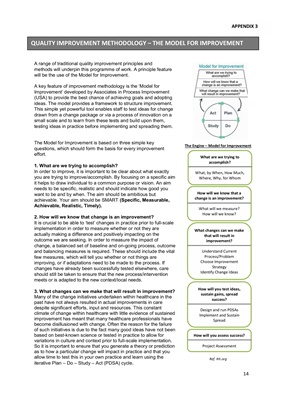
14
A range of traditional quality improvement principles and
methods will underpin this programme of work. A principle feature
will be the use of the Model for Improvement.
A key feature of improvement methodology is the 'Model for
Improvement' developed by Associates in Process Improvement
(USA) to provide the best chance of achieving goals and adopting
ideas. The model provides a framework to structure improvement.
This simple yet powerful tool enables staff to test ideas for change
drawn from a change package or via a process of innovation on a
small scale and to learn from these tests and build upon them,
testing ideas in practice before implementing and spreading them.
The Model for Improvement is based on three simple key
questions, which should form the basis for every improvement
effort.
1. What are we trying to accomplish?
In order to improve, it is important to be clear about what exactly
you are trying to improve/accomplish. By focusing on a specific aim
it helps to draw individual to a common purpose or vision. An aim
needs to be specific, realistic and should indicate how good you
want to be and by when. The aim should be ambitious but
achievable. Your aim should be SMART (Specific, Measurable,
Achievable, Realistic, Timely).
2. How will we know that change is an improvement?
It is crucial to be able to 'test' changes in practice prior to full-scale
implementation in order to measure whether or not they are
actually making a difference and positively impacting on the
outcome we are seeking. In order to measure the impact of
change, a balanced set of baseline and on-going process, outcome
and balancing measures is required. These should include the vital
few measures, which will tell you whether or not things are
improving, or if adaptations need to be made to the process. If
changes have already been successfully tested elsewhere, care
should still be taken to ensure that the new process/intervention
meets or is adapted to the new context/local needs.
3. What changes can we make that will result in improvement?
Many of the change initiatives undertaken within healthcare in the
past have not always resulted in actual improvements in care
despite significant efforts, input and resources. This constant
climate of change within healthcare with little evidence of sustained
improvement has meant that many healthcare professionals have
become disillusioned with change. Often the reason for the failure
of such initiatives is due to the fact many good ideas have not been
based on best-known science or tested in practice to allow for
variations in culture and context prior to full-scale implementation.
So it is important to ensure that you generate a theory or prediction
as to how a particular change will impact in practice and that you
allow time to test this in your own practice and learn using the
iterative Plan - Do - Study - Act (PDSA) cycle.
The Engine - Model for Improvement
Ref. IHI.org
QUALITY IMPROVEMENT METHODOLOGY - THE MODEL FOR IMPROVEMENT
APPENDIX 3
What are we trying to
accomplish?
What, by When, How Much,
Where, Why, for Whom
How will we know that a
change is an improvement?
What will we measure?
How will we know?
What changes can we make
that will result in
improvement?
Understand Current
Process/Problem
Choose Improvement
Strategy
Identify Change Ideas
How will you test ideas,
sustain gains, spread
success?
Design and run PDSAs
Implement and Sustain
Spread
How will we know?
How will you assess success?
Project Assessment